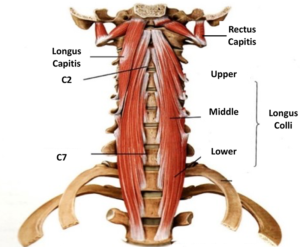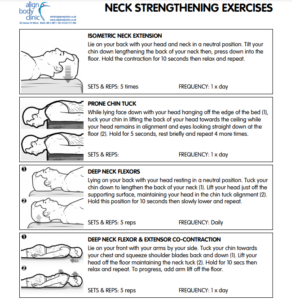Exercises That Reduce Neck Pain

 Strengthening your neck can help with neck pain.
Strengthening your neck can help with neck pain.
As many of us now spend increasing time at a computer and behind the wheel of a car neck pain is getting more common (1). When you have sat at the computer for a day’s work, or driven a long way it feels natural to give your stiff and sore neck a bit of a stretch, but have you ever thought that doing specific exercises to strengthen your neck would help with neck pain? Read on to find out what help neck strengthening exercises can be and how to do them!
Why is my neck sore?
Lots of different structures in the neck can cause pain, these include the muscles, joints, and other soft tissues like ligaments (2). There are several treatment options for the different types of neck pain we routinely see in our clinic (see our neck pain article for more details), but the presence of neck pain of any type has been shown to produce changes in how the muscles of the neck perform (3).
 Holding your head up is a complex business and involves a whole host of muscles on the front (neck flexors) and back (neck extensors) of the upper body. Different layers of neck muscles do different jobs as well. The more superficial muscles produce the movements you can easily see, such as turning the head and looking up and down. These muscles switch on when movement is needed and then switch off once that movement is complete. The deeper muscles (shown in the picture) that lie closest to your spine execute much more subtle functions that help position and stabilise joints, these muscles are active at a much lower intensity but for long periods (4).
Holding your head up is a complex business and involves a whole host of muscles on the front (neck flexors) and back (neck extensors) of the upper body. Different layers of neck muscles do different jobs as well. The more superficial muscles produce the movements you can easily see, such as turning the head and looking up and down. These muscles switch on when movement is needed and then switch off once that movement is complete. The deeper muscles (shown in the picture) that lie closest to your spine execute much more subtle functions that help position and stabilise joints, these muscles are active at a much lower intensity but for long periods (4).
What happens to my neck when it is sore?
How these superficial and deep muscles operate is altered in the presence of neck pain. Research has shown that the deep muscles become weak, easily fatigued, and are less able to perform their important tasks of stabilisation, while the superficial muscles become overactive, even when not being asked to produce movement. These changes are seen soon after the onset of neck pain and may not disappear once the neck pain has been relieved and have been seen in people who also suffer from cervico-genic headaches and after ‘whiplash’ injuries (3,5).
How can my neck strength be tested?
To test to see if a person who has neck pain has weakness or a lack of endurance in their deep neck muscles you can measure the amount of force a person can generate with the neck in certain positions, and how long they can hold certain positions for (6). These tests are easily performed in a clinical setting and will reveal if you need to improve your neck strength, you can see an example here.
If you have neck pain, and weakness or lack of endurance is identified through the testing then strengthening the relevant areas has been shown to help reduce neck pain, especially strengthening of the deep neck flexors (7).
help reduce neck pain, especially strengthening of the deep neck flexors (7).
To accurately assess whether or not neck strength exercises may benefit you it would be necessary to be assessed by one of our osteopaths in our central Bath Clinic. However, if you did wish to see which exercises can strengthen your deep neck muscles then the exercises below have been shown to do so and produce a reduction in neck pain (7).
Our expert osteopaths can provide you with a thorough assessment and diagnosis of your neck and provide a treatment plan to help you get rid of your pain as fast as possible.
Do you want to know what is causing your pain and if we can help? Why not take advantage of our new patient assessment introductory offer to get you started towards a tailor-made recovery plan for only £19.
Are you in a lot of pain and want to get better as soon as possible? If so then why not book in for our new patient consultation, with treatment on the day, for £75.
Disclaimer – If you have any neck pain you must seek medical assistance before beginning any rehabilitation program. These exercises are not intended as a recommendation of action to any individual and are for information purposes only.

References
1 – Vos T, Flaxman AD, Naghavi M, et al. (2013). Years lived with disability (YLDs) for 1160 sequelae of 289 diseases and injuries 1990-2010: a systematic analysis for the Global Burden of Disease Study 2010 [published correction appears in Lancet. Feb 23;381(9867):628. AlMazroa, Mohammad A [added]; Memish, Ziad A [added]]. Lancet.
2 – Narayan, P. Haid, R. (2001). Treatment of degenerative cervical disc disease. Neurol Clin, 19, pp217-229.
3 – Falla, D. L., Jull, G. A., & Hodges, P. W. (2004). Patients with neck pain demonstrate reduced electromyographic activity of the deep cervical flexor muscles during performance of the craniocervical flexion test. Spine, 29(19), 2108–2114.
4 – Page P, Frank CC, Lardner R. (2010). Assessment and treatment of muscle imbalance: the Janda approach. Human kinetics.
5 – Falla D. (2004). Unravelling the complexity of muscle impairment in chronic neck pain. Manual therapy. Aug 1;9(3):125-33.
6 – Muscle Performance in Neck Pain (2021). Physio-pedia online article – Available at – https://www.physio-pedia.com/Muscle_Performance_in_Neck_Pain#cite_note-:1-9, accessed 30/8/2021.
7 – Nazari G, Bobos P, Billis E, MacDermid JC. (2018). Cervical flexor muscle training reduces pain, anxiety, and depression levels in patients with chronic neck pain by a clinically important amount: A prospective cohort study. Physiother Res Int, 23(3):e1712.

 Strengthening your neck can help with neck pain.
Strengthening your neck can help with neck pain.